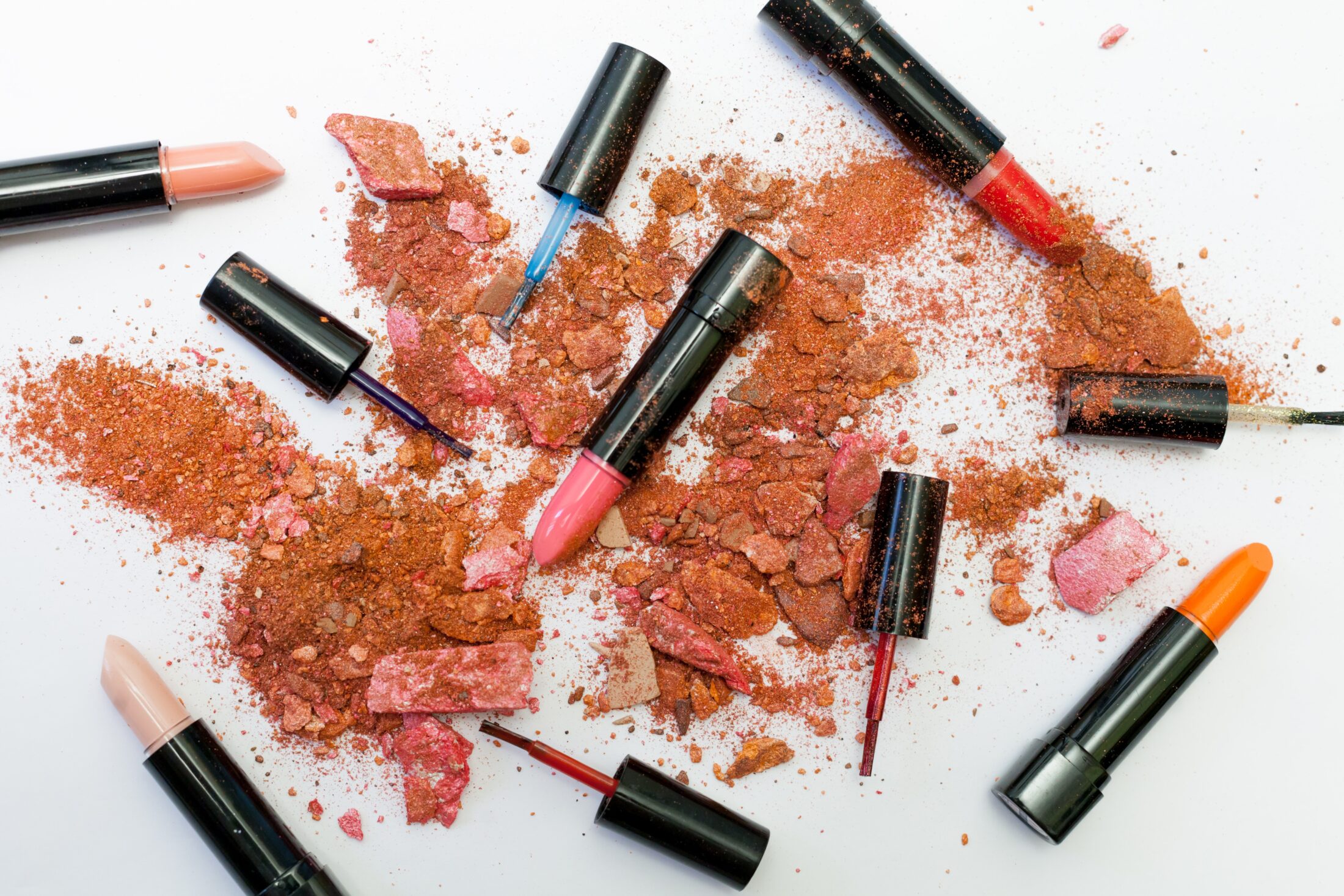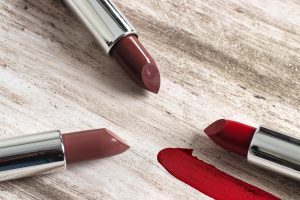



We’ve all been there: you’re out and about, rocking your favorite red lipstick, when suddenly and inevitably, disaster strikes in the form of a smudge or stain on your outfit.
And with face masks now being an essential part of our everyday lives, it’s more likely than ever that we’ll experience the occasional mishap.
Any internet search will give you a few ideas on how to remove lipstick, but the real solutions come from those in the beauty industry who know which ingredients actually cause stains.
Our expert team has decades of experience working with all kinds of lip color products, so we know exactly what works (and what doesn’t) when it comes to removing lipstick stains.
In this guide, we’ll give you the inside scoop on what’s actually staining your clothes, how to effectively remove it, and what to avoid so you don’t make the problem worse.
A product that slides easily on one’s skin should not be so tough to remove from clothes. The culprit is the stratum corneum, a barrier between the innermost skin and outside irritants, that protects our lips (and therefore makes it hard to get lipstick off).
When you accidentally smudge your cuff against your mouth, the pink that gives you the perfect pout penetrates deep into the fabric fibers and causes a stain.
More precisely, the ingredients in your favorite petal pink fabric are the ones to blame for any stains.
The three ingredients commonly present in lipsticks are:
If you’re looking for an easier way to remove lipstick from your clothing, go for lipsticks that contain natural wax blends like beeswax, carnauba wax, and/or candelilla wax.
For example, mineral oil, which comes from petroleum, can be very hard to get out of your clothes. On the other hand, less harsh oils like jojoba and castor oil are good for your fabrics and also hydrate better than a petroleum-based oil.
Synthetic colors can sometimes be notoriously difficult to remove. If you’re not careful, all three of these ingredients have the potential to stain your clothing – or at the very least, the inside of your favorite cloth masks.
But before you give up and either throw out the garment or repurpose it into a cleaning rag, try one of these lipstick stain-removing solutions from the pros.
There are three main ingredients in most lipsticks that can lead to staining, so you should use a method that specifically removes one of them.
Keep in mind that because usually all three ingredients are present in lipstick, you may need to use more than one method to completely get rid of the stain. Time is critical when it comes to stains, so make sure you treat them as soon as possible.
Once you’ve treated the stain with one of the below methods, remember that you’ll almost always need to wash the garment.
To avoid setting the stain, use cold water instead of hot water. And since scrubbing can make it worse or cause it to spread, simply dab and blot it—not smear.
Clear, mild dish soap or an all-purpose cleaner (like Dr. Bronner’s) will work just fine. You’ll also need a towel and some clean paper towels.
Here is the method: Place your garment on a surface where the stain will not spread. Pour a dime-sized amount of dish liquid onto the stain, and let it sit for ten to fifteen minutes. Turn the garment over, and blot (not rub or scrub) the area with a clean paper towel.
Dish soap not only eliminates grease from dishes, but it also helps to remove wax and pigments from your clothing garments. It is a great solvent that can help remove oils from lipstick-stained fabrics, too.
For this method, you will need hairspray with alcohol and some clean paper towels.
Here is the method: Blot the stain with a paper towel after spraying hairspray on it.
Hairspray with alcohol can help remove stains quickly. Some hair sprays don’t contain alcohol because it can be drying to your hair, which means that it won’t work for stain removal.
All you need is some isopropyl alcohol (or hand sanitizer if you’re in a pinch) and cotton balls.
Follow these steps to lift the stain using alcohol:
We all know that alcohol is a great solvent, but did you know it can also remove makeup stains?
If you find yourself with lipstick on your clothing, grab some vodka and dab it on the stain. Follow up with an ice cube, and you may be able to save your shirt (and your dignity).
In order to follow these steps, you will need acetone nail polish remover, cotton swabs, a clean toothbrush, and either clean cloth or paper towels.
Remove the nail polish with a cotton swab and some acetone. Gently tap the stain with a toothbrush, making sure not to scrub too hard. Blot away any remaining residue with either a paper towel or clean cloth.
While acetone is a powerful solvent and can remove difficult stains, it can also cause colors to run. So use with caution. You should never use nail polish remover on fabrics that contain acetate, as it will damage the fibers.
Some synthetic silks and wool fabrics contain acetate, so be sure to always check the label before using any type of cleaner on your clothes.
For this project, you will require: petroleum jelly.
Use the following method to remove your stain:
First, use your finger to apply a thin layer of petroleum jelly directly on top of the stain. Second, launder as you usually would. After removing it from the wash, check to see if the stain is visible. If there is still evidence of the original placemark, then repeat this entire process. However, if you’d like to try something different, feel free!
The most important part is that under no circumstances should you put this garment in the dryer – doing so will set the mark permanently.
Although petroleum jelly is excellent at removing pigment stains from clothing, beware of using too much as it can create an even more difficult stain to remove.
The materials you’ll need for this task are lemon juice, baking soda, and a clean cloth.
To use this method, mix together equal parts lemon juice and baking soda until you form a paste.
Rub the mixture onto the stain, wait half an hour, then check to see if the stain has lifted. If not, scrub it gently with a clean brush on non-delicate fabrics.
If you’ve got a set-in stain that you didn’t notice right away, reach for the lemon juice and baking soda. These two ingredients can break down even tough stains.
In order to do this, you will need shaving cream that is foam-based instead of gel.
A little known hack for difficult stains is to pretreat them with shaving cream! Simply dab some on the problematic area and blot it dry.
Once you’ve done that, wash the item as you normally would, and voila! The stain should be gone!
Shaving cream contains soapy ingredients that make it ideal for removing stains, even if you don’t have dish soap or other solvents nearby.
If you use natural lipsticks instead of synthetic, petroleum-based lipsticks, it’s much less likely that you’ll have to deal with a stubborn stain. Opt for all-natural lipsticks.
Wear natural lipstick with confidence, knowing that it can be easily removed from fabric with a simple cleanser, detergent, mild dish soap, or hair shampoo.
Keep your clothes clean by choosing either a matte lip color or a tinted balm. The former is more difficult to transfer, while the latter can easily be wiped away if it comes into contact with clothing.
A little bit of lip color goes a long way, and it’s less likely to rub off on your clothes if you don’t cake it on. If you’re not at home when the inevitable happens, carry around a Tide-To-Go or another brand of stain removal pen so that you can take care of the problem right away.
Don’t want to repeatedly wash your masks? Try ditching the close-fitting ones. Also, blotting your lips with powder or a tissue pre-mask can help avoid stains.
Although some lipstick stains can be permanent, you have a better chance of removing them if you choose lip colors with natural ingredients that come off easily with soap and water.
Sustainable Shades For many DIY enthusiasts and design aficionados, a fresh coat of paint is…
Cruelty-Free Solutions for a Healthier You Chronic inflammation can be a relentless foe, disrupting our…
Unleashing Your Brain's Potential In today's fast-paced world, maintaining sharp mental focus and cognitive agility…
Exploring DIY Organic Makeup Fixers For the eco-conscious beauty enthusiast, the quest for flawless makeup…
A Sensitive Exploration The clean beauty movement has taken the beauty world by storm. Consumers…
Taming the Mane Frizz – the bane of smooth hair dreams. It can transform a…
This website uses cookies.